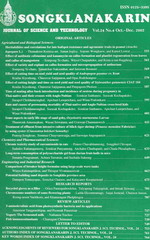ThaiScience
ThaiScience
SONGKLANAKARIN JOURNAL OF SCIENCE & TECHNOLOGY
Volume 41, No. 05, Month SEPTEMBER, Year 2019, Pages 974 - 983
The relationship between geological factors and the distribution of saline soil a case study in the khon kaen basin of thailand
Rungroj Arjwech, Mark E Everett, Patcharasu Wanakao
Abstract Download PDF
Soil and groundwater salinity poses a serious problem in Khon Kaen Province of Thailand and causes major reductions to crop productivity. In this study, aerial photo interpretation, field studies, and borehole lithology log data were analyzed to explore the spatial relationship between geological structure and the distribution of salinity. The results show that geological structures play an important role in determining the salinity distribution. Slight and moderate salinity are generally found over syncline structures and rock formation boundaries, whereas severe salinity is generally found over anticline structures and around depressions containing rock salt. All three categories of salinity (slight, moderate, and severe) are encountered along fractures associated with braided streams and faults associated with meandering streams. The electrical resistivity tomography results showed that the depth of saline groundwater was between 5 and 30 m and its distribution was related to geomorphology. Salinity distributions are natural occurrences controlled by subsurface geological structures and geomorphology.
Keywords
electrical resistivity tomography, soil salinity distribution, saline groundwater, geological structure, rock saltSONGKLANAKARIN JOURNAL OF SCIENCE & TECHNOLOGY
Published by : Prince of Songkla University
Contributions welcome at : http://rdo.psu.ac.th
